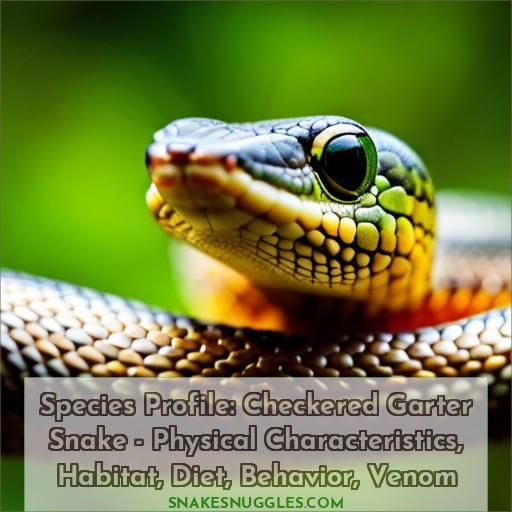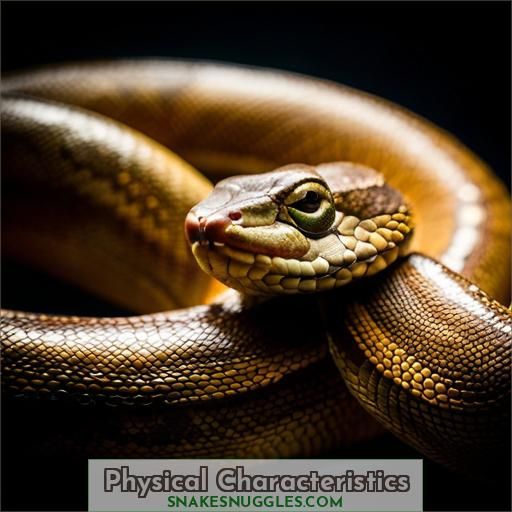This site is supported by our readers. We may earn a commission, at no cost to you, if you purchase through links.

The checkered garter snake is an alluring reptile that flourishes in the verdant wetlands of the southeastern United States. Its sharp senses warn it of threats as it hunts for a varied array of prey, including frogs, toads, fish, and rodents.
This nimble and evasive species depends on towering vegetation for hunting and escaping predators, and its mottled coloration provides superb camouflage.
Although listed as threatened since 1993, conservation efforts aim to safeguard this species, which faces difficulties from invasive plants and the effects of climate change.
Table Of Contents
Key Takeaways
- The checkered garter snake is a carnivorous species that feeds on a variety of prey, including small frogs, toads, fish, earthworms, small lizards, small rodents, and even eggs.
- During the breeding season, which occurs in late March through early April, the snakes consume small frogs, toads, and small fish.
- The checkered garter snake relies on tall vegetation for hunting and escape from predators. As their populations move westward, they use irrigation canals as lifelines to access new wetland habitats.
- The species is listed as threatened since 1993 due to habitat fragmentation, loss, and degradation caused by urbanization, infrastructure development, and agricultural conversion. Conservation efforts include habitat restoration, enhancement, or creation, and the development of management plans and best management practices oriented to checkered garter snake conservation.
Habitat
The checkered garter snake relies on tall vegetation to both hunt its prey and evade predators. As the species’ populations move westward, they’ve been spotted traveling along irrigation canals to access new wetland habitats.
Requirements: Tall Vegetation for Hunting and Escape From Predators
The checkered garter snake thrives in wetlands, where tall vegetation provides the perfect cover for hunting and evading predators. This species has evolved to seamlessly blend into its surroundings, using the lush foliage as both a hiding spot and a launchpad for ambushing unsuspecting prey.
To s쳮d in this environment, the checkered garter snake relies on a few key adaptations:
- Camouflage coloration that mimics the dappled light and shadows of its habitat.
- Keen senses that alert it to approaching threats, allowing for a lightning-fast retreat.
- Agility that enables it to dart through the dense vegetation, disappearing in the blink of an eye.
With these tools at its disposal, the checkered garter snake is a formidable hunter and an elusive resident of the wetlands.
Populations Are Moving Westward, Traveling Along Irrigation Canals
As the giant garter snake seeks tall vegetation for hunting and escape, it’s also traversing a changing landscape. With their habitats shrinking due to urban sprawl and agriculture, these snakes are making a bold move westward.
They’re using irrigation canals as lifelines, threading through the human-altered terrain like secret passages. This westward movement isn’t just a tale of adventure; it’s a survival strategy against the backdrop of climate change and habitat loss.
As a threatened species, their journey highlights the resilience required to adapt in a world where wetlands are vanishing at an alarming rate.
Food
The checkered garter snake, Thamnophis marcianus, is a carnivorous species that feeds on a variety of prey. During the breeding season, which occurs in late March through early April, they consume small frogs, toads, and small fish. In addition, they prey on earthworms, small lizards, small rodents such as mice, and even eggs.
These snakes are polygynous, meaning one male mates with more than one female. After the gestation period of 80-105 days, females give birth to 6-35 live young. The young are independent at birth and don’t require parental care.
Checkered garter snakes are found in a variety of habitats, including wetlands, agricultural wetlands, and adjacent uplands. They require tall vegetation for hunting and escape from predators. Their populations are moving westward, traveling along irrigation canals.
Behavior
The checkered garter snake is a diurnal species, meaning they’re active during the day. They can also be nocturnal in some areas to avoid the heat.
The checkered garter snakes are known to be territorial and have been observed engaging in combat-like behavior when two males cross paths.
During the breeding season, which typically takes place from late March to early April, they form large communal mating balls where multiple males compete for access to a single female.
After the gestation period of 80-105 days, females give birth to live young, usually with clutches of 3-20 snakes. These juvenile snakes are independent at birth and don’t require parental care.
Checkered garter snakes become reproductively mature at 1.5 years for males and 2 years for females.
Physical Characteristics
The checkered garter snake can grow up to 7 inches (162 centimeters) in length. Its belly ranges in color from cream to pale blue, and it was listed as a threatened species on October 20, 1993.
Length: Up to 63.7 Inches (162 Centimeters)
Imagine unrolling a tape measure across the ground, and it stretches out to an impressive 63.7 inches. That’s the potential length of a checkered garter snake, a creature whose checkered coloration mirrors the complexity of its life.
Within its geographical range, this snake’s survival hinges on wetland habitats, now threatened by encroaching human activity. As populations decline, the urgency for future conservation measures becomes a clarion call for action.
Listed as Threatened on October 20, 1993
The checkered garter snake, a species native to the southeastern United States, was listed as threatened on October 20, 1993, under the Endangered Species Act of 1973. This listing was due to the threats posed to its habitat and range, which include habitat fragmentation, loss, and degradation caused by urbanization, infrastructure development, and agricultural conversion.
To address these threats, conservation efforts have been implemented to guide the direction of recovery and protect the species. These efforts include habitat restoration, enhancement, or creation, and the development of management plans and best management practices oriented to giant garter snake conservation. Additionally, population monitoring programs have been established to track the status of the species and guarantee its long-term survival.
Despite these conservation efforts, the checkered garter snake faces several ongoing threats, including changes in water availability, levee and canal maintenance, water management, and water deliveries that don’t account for the species; water transfers resulting from cropland idling/shifting, reservoir releases, conservation measures, or groundwater substitution; small populations; and invasive aquatic species.
Belly is Cream to Pale Blue
The belly of the checkered garter snake can range from cream to pale blue, depending on the individual and its location. The bluish coloration is more common in specimens from southern Georgia and Florida. The belly coloration, along with the ventral color, can vary between individuals and may be influenced by factors such as habitat and temperature.
Conservation Status
The checkered garter snake’s conservation status is quite complex. While it’s protected throughout Georgia, it faces threats from invasive aquatic plants, climate change impacts like flooding and drought, and its dependence on permanent wetlands makes it vulnerable to drought.
Protected Throughout Georgia
In Georgia, the checkered garter snake is considered a protected species. This means that they’re legally protected from harm or exploitation.
The state has implemented various measures to guarantee their survival and well-being. This includes monitoring their populations, enforcing laws against their capture or harm, and providing suitable habitats for them to thrive.
As a result, the checkered garter snake population in Georgia is relatively stable and healthy.
Invasive Aquatic Plants and Removal Techniques
Invasive aquatic plants and removal techniques pose a significant threat to the checkered garter snake‘s habitat. These plants can degrade the quality of the snake’s habitat, making it less suitable for their survival. The removal of these plants is essential to maintain the snake’s habitat and prevent further degradation.
Physical control methods, such as hand-pulling, hand-netting, and cutting, are used to remove aquatic plants. These techniques are often combined with other methods like chemical or mechanical control to effectively manage certain plant species. However, it’s important to remember the disposal of controlled plants, as they can quickly regrow if not properly managed.
In the case of the checkered garter snake, the recovery plan for the giant garter snake (Thamnophis gigas) highlights the importance of maintaining suitable aquatic habitat for the species. This includes the presence of emergent and bankside vegetation, which provides cover from predators and may serve in thermoregulation. Clearing of emergent aquatic vegetation, such as cattails and bulrushes, from canals to facilitate water flow could impact giant garter snake habitat.
Invasive aquatic plants can also impact the snake’s habitat by reducing the availability of suitable prey and altering the ecological balance of the wetland ecosystem. The recovery plan for the giant garter snake emphasizes the importance of protecting existing habitat, areas identified for restoration or creation, and areas that will provide connectivity between preserved areas of habitat.
Impacts of Climate Change, Including Flooding and Drought
Climate change is having a significant impact on the habitat and survival of the checkered garter snake. Changes in precipitation patterns, increased drought, and altered stream flows are reducing the availability of suitable habitats for these snakes, particularly in areas where they forage for amphibians in aquatic environments. Additionally, warmer water temperatures may accelerate frog larval development rates, potentially benefitting California red-legged frogs, but effects on tadpole development aren’t well understood.
The checkered garter snake is sensitive to changes in climate factors that reduce prey availability, as well as changes in disturbance regimes that directly impact reproduction. These changes are exacerbated by non-climate stressors such as land-use conversion to development and agriculture, invasive species, exposure to pesticides, roads/highways/trails, dams/water diversions, and illegal collection.
Invasive aquatic plants and removal techniques are also threats to the checkered garter snake, as they can impact habitat availability, quality, and connectivity. The impacts of climate change, including flooding and drought, are further complicating efforts to protect and conserve this species.
Drought Threatens Due to Dependence on Permanent Wetlands
Drought’s grip tightens, threatening the Checkered Garter Snake‘s survival. As wetlands shrink, these snakes face a habitat loss crisis. Conservation efforts ramp up, with population monitoring as a beacon of hope. Amidst climate change’s harsh reality, every drop of water counts in the battle to save their slithery skins.
Frequently Asked Questions (FAQs)
What is the average length of a checkered garter snake?
Though the checkered garter snake can grow up to 49 inches, most measure a more modest 18-26 inches. Don’t be fooled by their unassuming size – these slithering wonders pack a punch in their compact frames.
Is the checkered garter snake venomous?
No, the checkered garter snake isn’t venomous. These snakes have solid teeth but no venom glands, so they pose no threat to humans. Their diet consists primarily of small prey like worms, frogs, and fish.
What do checkered garter snakes eat?
Checkered garter snakes are true omnivores, feasting on a smorgasbord of worms, slugs, frogs, toads, salamanders, fish, and tadpoles. Like a skilled chef, they whip up a delectable meal from nature’s diverse pantry.
How do checkered garter snakes reproduce?
Checkered garter snakes are viviparous, meaning they give birth to live young. Their litters can exceed 50 offspring, which they deliver from mid-summer to early fall. This guarantees their young have sufficient time to grow before winter.
What is the conservation status of the checkered garter snake?
The checkered garter snake’s conservation status varies across its range – while common in many areas, it’s protected in Georgia. However, habitat loss threatens populations in some regions, underscoring the need for vigilant conservation efforts.
Conclusion
Though the checkered garter snake may be facing an uphill battle, conservation efforts are steadfastly working to turn the tide. By protecting the species’ crucial wetland habitats and mitigating the impacts of climate change, we can guarantee that this resilient reptile continues to call the southeastern United States home for generations to come.
Ultimately, the destiny of the checkered garter snake rests in our hands, and with vigilance and swift action, we can keep this unique species profile alive and flourishing.











